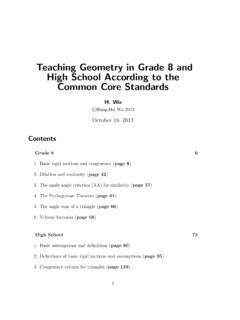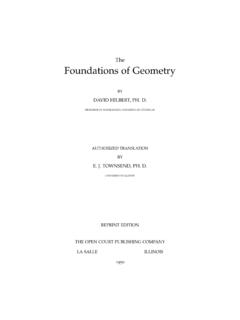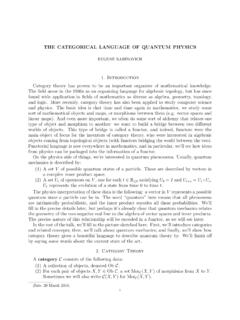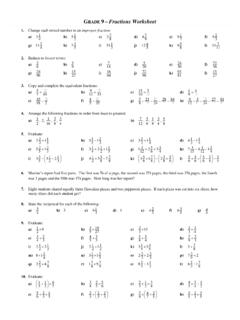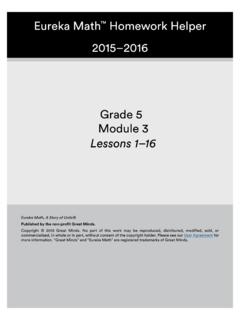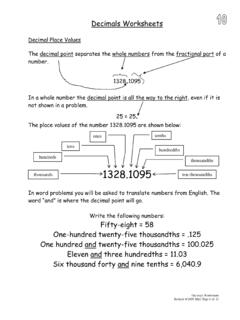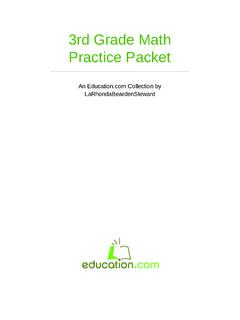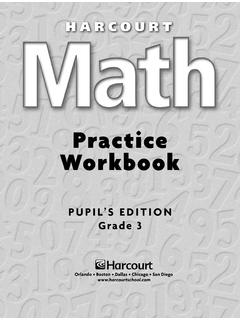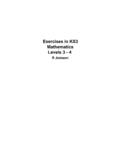Transcription of Teaching Fractions According to the Common Core Standards
1 Teaching Fractions According to theCommon Core StandardsH. Wuc Hung-Hsi Wu 2013 August 5, 2011 (revised February 8, 2014)ContentsPreface2 grade 35 grade 417 grade 533 grade 659 grade 780 I am very grateful to David Collins and Larry Francis for very extensive juge:Accus e, vous t acherez d etre accus e:Je t acherai d etre clair. G. Courteline1 This document gives an expanded view of howthe Common Core Standardson Fractions in grades 3-7may be taught. As of 2014, it may be unique in thatit is written for the classroom teachersby someone who has been Teaching fractionsto elementary and middle school teachers since year 2000 in a way that is in almostcomplete agreement with the Common Core Standards . The specific Standards thatare addressed in this article are listed at the beginning of each grade insan learning of Fractions may be divided roughly into two stages.
2 In theinitial stage that would be grade 3 and part of grade 4 in the Common Core Stan-dards students are exposed to the various ways Fractions are used and how simplecomputations can be made on the basis of simple analogies and intuitive learn to represent Fractions with fraction strips (made of paper or just draw-ings), fraction bars, rectangles, number lines, and other manipulatives. Even in theexploratory and experiential stage, however, one can help students form good habits,such as always paying attention to a fixedunit(the whole) throughout a discussionand always being as precise as practicable. Regarding the latter issue of precision,we want students to know at the outset that theshapeof the rectangle is not the whole ; its area is. (This is one reason that a pizza is not a good model for thewhole, because there is very little flexibility in dividing the area of a circle into equalparts except by using circular sectors.)
3 The other reason is that, unlike rectangles, itcannot be used to model fraction multiplication.)The second stage is where the formal mathematical development of Fractions be-gins, somewhere in grade 4 According to these Common Core Standards . In grade 4,1 Quoted in the classic,Commutative Algebra, of Zariski-Samuel. Literal translation: The judge: The defendant, you will try to be brief. The defendant replies, I will try to be clear. 2the fact that a fraction is anumberbegins to assume overriding importance on ac-count of the extensive computations students must make with Fractions at that pointof the school curriculum. They have to learn to add, subtract, multiply, and dividefractions and use these operations to solve problems. Students need a clear-cut modelof a fraction (or as one says in mathematics, adefinitionof a fraction) in order tocome to grips with all the arithmetic operations.
4 The shift of emphasis from multiplemodels of a fraction in the initial stage to an almost exclusive model of a fraction as apoint on the number line can be done gradually and gracefully beginning somewherein grade 4. This shift is implicit in the Common Core Standards . Once a fractionis firmly established as a number, then more sophisticated interpretations of a frac-tion (which, in a mathematical context, simply mean theorems ) begin to among them is the division interpretation: we must explain,logically, tostudents in grade 5 and grade 6 thatmn, in addition to being the totality ofmpartswhen the whole is partitioned intonequal parts, is also the number obtained when mis divided byn , where the last phrase must be carefully explained with the helpof the number line. If we can make students realize that this is a subtletheoremthatrequires delicate reasoning, they will be relieved to know that they need not feel badabout not having such a conceptual understanding of a fraction as they are usuallyled to believe.
5 Maybe they will then begin to feel that the subject of Fractions is onetheycanlearn after all. That, by itself, would already be a minor triumph in schoolmath most sophisticated part of the study of Fractions occurs naturally in grades6 and 7, where the concept of fraction division is fully explained. Division is thefoundation on which the concepts of percent, ratio, and rate are built. Needless tosay, it is the latter concepts that play a dominant role in applications. The discus-sion given here of these concepts is, I hope, at once simple and comprehensive. Iwould like to call attention to the fact that all three concepts percent, ratio, andrate are defined simply as numbers and that, when they are so defined, problemsinvolving them suddenly become transparent.
6 See page 67 to page 74. In particular,one should be aware that the only kind of rate that can be meaningfully discussed inK-12 isconstant rate. A great deal of effort therefore goes into the explanation of themeaning of constant rate because the misunderstanding surrounding this concept ismonumental as of 2011. In grade 7, the difficult topic of converting a fraction to a3decimal is taken up. This is really a topic in college mathematics, but its elementaryaspectcanbe explained. Due to the absence of such an explanation in the literature,the discussion here is more detailed and more complete than is found spite of the apparent length of this article, I would like to be explicit aboutthe fact thatthis document is not a have tried to give enough of anindication of the most basic facts about Fractions and, in the process, had to giveup on mentioning the fine points of instruction that must accompany any teacher sactual lessons in the classroom.
7 For example, nowhere in this document did I mentionthe overriding importance of theunit(on the number line). Another example is thediscussion of the addition of mixed numbers on page 33, which only mentions themethod of converting mixed numbers to improper Fractions . Needless to say, studentsshould also know how to add mixed numbers by adding the whole numbers and theproper Fractions separately. The same for the subtraction of mixed numbers. Forsuch details, I will have to refer the reader to the following volume by the author:H. Wu,Understanding Numbers in Elementary School Mathematics,American Mathematical Society, , see Sections and for a discussion of the importance of the unit,and Sections and for the addition and subtraction of mixed numbers.
8 In gen-eral, this reference though written before the Common Core Standards providesa development of Fractions that is essentially in total agreement with the CommonCore GRADEN umber and Operation understanding of Fractions as Understand a fraction1/bas the quantity formed by 1 part when a whole is parti-tioned intobequal parts; understand a fractiona/bas the quantity formed byaparts ofsize1 Understand a fraction as a number on the number line; represent Fractions on anumber line Represent a fraction1/bon a number line diagram by defining the interval from0 to 1 as the whole and partitioning it intobequal parts. Recognize that each part hassize1/band that the endpoint of the part based at 0 locates the number1/bon thenumber Represent a fractiona/bon a number line diagram by marking offalengths1/bfrom 0.
9 Recognize that the resulting interval has sizea/band that its endpoint locatesthe numbera/bon the number Explain equivalence of Fractions in special cases, and compare Fractions by reasoningabout their Understand two Fractions as equivalent (equal) if they are the same size, or thesame point on a number Recognize and generate simple equivalent Fractions , ,1/2 = 2/4,4/6 = 2 why the Fractions are equivalent, , by using a visual fraction Express whole numbers as Fractions , and recognize Fractions that are equivalentto whole numbers. Examples: Express 3 in the form3 = 3/1; recognize that6/1 = 6;locate4/4and 1 at the same point of a number line Compare two Fractions with the same numerator or the same denominator byreasoning about their size.
10 Recognize that comparisons are valid only when the two frac-tions refer to the same whole. Record the results of comparisons with the symbols>,=,or<, and justify the conclusions, , by using a visual fraction grade 3, students are introduced for the first time to the (part-whole) conceptof a fraction and the language associated with its use. Among the many ways tomodel a fraction, those involving a rectangle and the number line are singled out fordiscussion; these are not models of shape a rectangle and a line segment butmodels ofareaandlength. In other words, even in an intuitive discussion of fractionsfor beginning students, we should instill the right way to think about them: these arenumbers. One advantage of the number line model is that it allows an unambiguousformulation of the basic concepts of equal , smaller and bigger among experimentations on the number line will expose students to the phenomenonof equivalent meaning of fractionsStudents can be introduced to Fractions informally by the use ofdiscrete objects,such as pencils, pies, chairs, etc.
